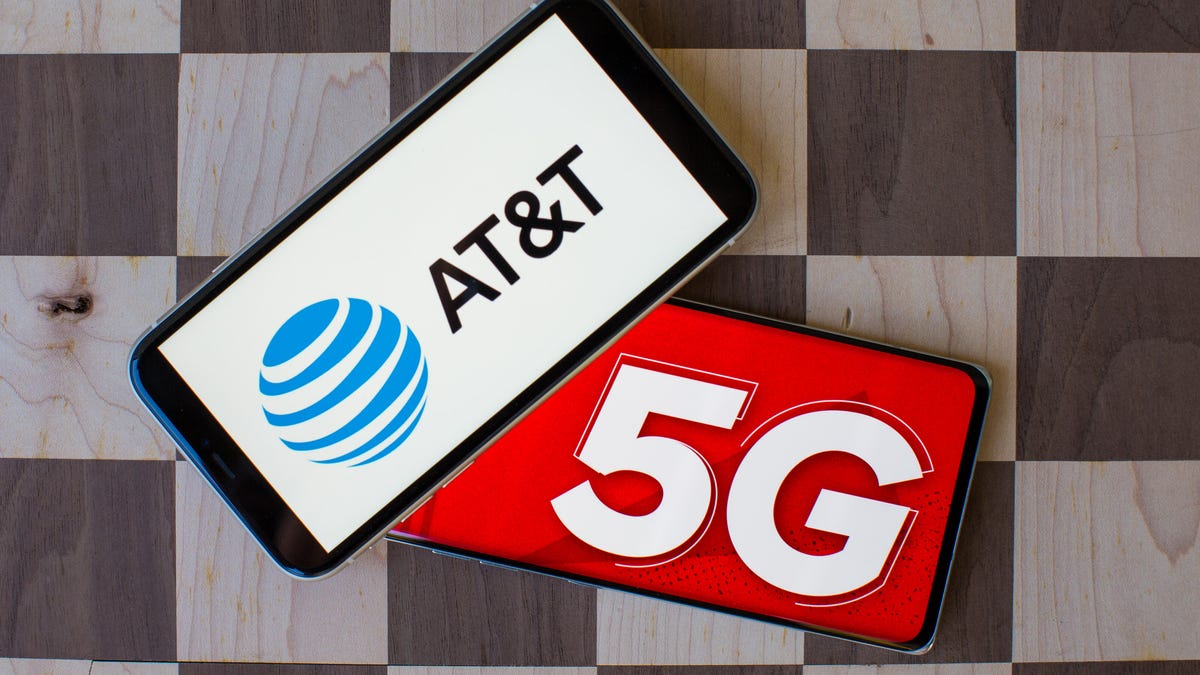Amid FAA drama, AT&T's 5G upgrade starts Wednesday in 'limited parts' of 8 metro areas
The carrier hopes to cover 200 million people with midband spectrum by the end of 2023.

AT&T's next big 5G upgrade is happening, though its launch will be on a significantly smaller scale than rival Verizon . On Wednesday the carrier announced that it will be turning on its new C-band 5G network (what it calls "5G Plus") in "limited parts" of eight metropolitan areas.
Those areas include Dallas-Fort Worth, Houston, Austin, Chicago, Detroit, Jacksonville, Orlando and Miami. Users in those cities, with a compatible device and an unlimited plan, should see 5G speeds that are "up to 3x" faster than what they were getting on AT&T's 4G LTE .
Rival Verizon, which purchased significantly more C-band last year, planned to cover 100 million people with the signal this month and has touted peak download speeds of 1 gigabit per second. The carrier has since rolled that number back to 90 million people as a result of the Federal Aviation Administration and aviation industry's latest objection to C-band deployments around airports.
Even so, Verizon's launch is still significantly larger than AT&T's initial deployment. The carrier was previously hoping to reach 70 to 75 million people with C-band by the end of 2022, but supply chain issues in 2021 impacted that goal, Chris Sambar, AT&T's executive vice president of technology operations, told CNET.
Sambar declined to provide a target for where the carrier will be at the end of 2022, but says that "the build-out will be moving in earnest in the second half of this year" once it gets the equipment that it needs. "That's when we can really start going gangbusters."
Sambar notes that as users load onto the new C-band network they should expect consistent download speeds between 100 and 200 megabits per second.
He adds that the carrier has been taking steps to "future-proof" its network as it has been preparing for the C-band launch to get it ready to add additional spectrum bands in the future. "So from our perspective, if we're going to put C-band up, let's put C-band up along with everything else that we want to put up together."
Last week it was revealed that the carrier recently spent another $9.1 billion to acquire additional midband spectrum through an auction with the Federal Communications Commission. Due to auction rules, Sambar was not allowed to discuss the carrier's plans for that spectrum. AT&T aims to cover 200 million people with midband spectrum by the end of 2023.
Adding the missing middle piece
Unlike T-Mobile , which has built out a robust 5G network thanks in large part to the midband spectrum it acquired in its Sprint merger, AT&T and Verizon have lagged behind in building out 5G. It's why both carriers have spent so much to acquire C-band and other forms of midband spectrum.
Until now both carriers have previously relied primarily on a combination of technologies known as millimeter-wave and low-band spectrum. Millimeter-wave has excellent performance but significantly limited coverage that is often only available on certain street corners or in select parts of stadiums, airports or arenas. Low-band 5G offers strong coverage, but its performance is often equivalent to 4G LTE rather than being better.
With the addition of C-band, AT&T will be able to add a 5G network that operates in the middle, bringing much faster performance than low-band 5G while offering significantly better coverage than millimeter-wave. The carrier spent over $27 billion last year to purchase the wireless spectrum as it looks to bolster its network.
AT&T says its low-band 5G network currently covers over 255 million people, though again this experience is largely similar to a good 4G LTE experience. Its faster millimeter-wave network (also called "5G Plus") is available in certain parts of 44 cities as well as in parts of nearly 30 stadiums, airports and arenas.
The turbulent road to C-band
The road to C-band has been bumpy for AT&T and Verizon. Both providers had initially planned to launch the new airwaves late last year but ran into resistance. The Federal Aviation Administration, airlines and other members of the aviation industry have claimed the frequencies used by C-band would interfere with the altimeters used in planes and impact the ability to land flights in low-visibility conditions.
The carriers, as well as the CTIA, the wireless industry's lobbying group, have disputed these claims and noted how C-band 5G has been deployed in nearly 40 countries with no issues for flights. The carriers had agreed to postpone the launch twice -- first to Jan. 5 then again to Jan. 19 -- but airlines have since warned of significant flight delays if the launch went on as scheduled.
On Tuesday AT&T confirmed that would still launch C-band 5G as planned on Wednesday, but that it had "voluntarily agreed to temporarily defer turning on a limited number of towers around certain airport runways" as it worked with the FAA and the aviation industry.
As for if it would seek any remediation from the government to reimburse the carrier for all of the delays, Sambar wouldn't rule it out but said that it isn't the carrier's goal.
"I don't think we've gotten there yet, but I wouldn't say it's out of the question," he says. "Ideally, we get to a resolution here ... in the end, US consumers need strong 5G on midband spectrum that's been auctioned and bought by the carriers. Consumers need that.
"It's good for our economy, and it's good for America and everybody knows that. And so we'd rather not get our money back and get some spectrum back or just get our money back. We'd rather launch it the way it was intended to be launched based on years of studies on that spectrum in the US and abroad. We want to launch it and get the service up for US consumers."

